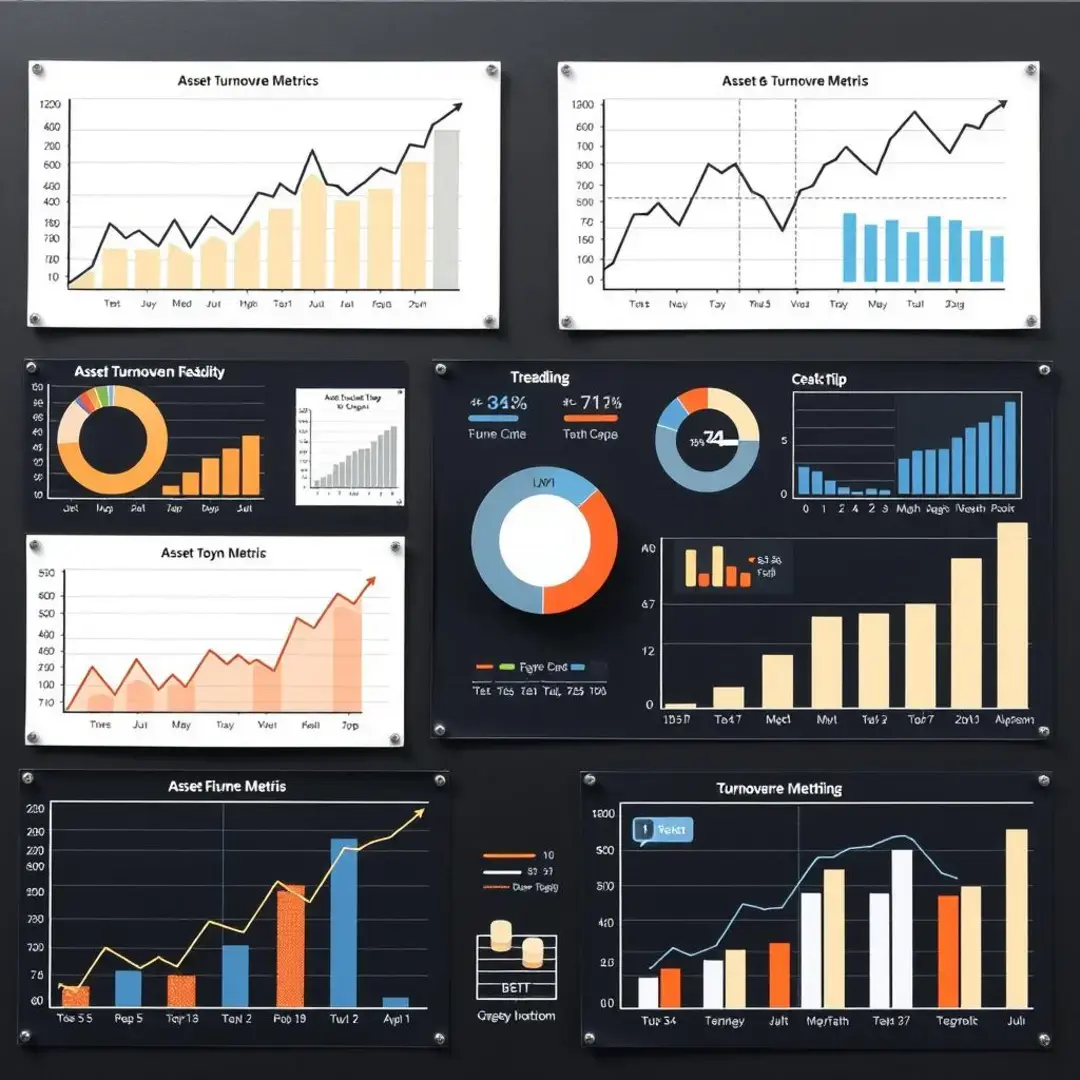Asset turnover ratio: Gauging company performance
Understanding the Asset Turnover Ratio

What is the asset turnover ratio?
The asset turnover ratio is a critical financial metric that measures how efficiently a company utilizes its assets to generate sales. Specifically, it relates a company’s total sales revenue to its total assets, providing insights into how effectively a business is utilizing its resources. The formula to calculate the asset turnover ratio is:
Asset Turnover Ratio = Net Sales / Average Total Assets
This ratio helps stakeholders determine whether a company is using its assets effectively to drive revenues, indicating operational efficiency and performance stability over time.
There are various types of asset turnover ratios, each offering valuable insights into specific facets of a company’s operations. For instance, the fixed asset turnover ratio focuses on how well a company uses its fixed assets—like machinery and plants—to generate sales. In contrast, inventory turnover looks at how quickly a company sells its inventory, reflecting the efficiency of management in converting stock into revenue.
Understanding these different ratios can provide a layered view of a company’s efficiency across different asset categories and help identify areas for improvement.
Why is the asset turnover ratio important?
The asset turnover ratio is essential for evaluating operational efficiency because it highlights how effectively a company is using its resources to generate revenue. A higher ratio indicates that a company is generating more revenue per dollar of assets, which is a positive sign of management effectiveness and operational prowess.
Moreover, this ratio helps identify companies that excel in using their resources compared to competitors, making it a useful benchmark for investors and analysts alike.
The link between asset turnover and profitability is strong; efficient asset utilization often leads to higher profit margins and return on investment (ROI). Companies with a high asset turnover ratio typically indicate robust sales relative to their asset base, making them attractive investment candidates. Furthermore, a high ratio suggests that management is adept at leveraging assets to enhance revenue, ultimately leading to improved overall profitability.
By analyzing the asset turnover ratio in conjunction with profit margins, stakeholders can gain insights into a company’s operational strategies and financial health.
Calculating and Interpreting the Asset Turnover Ratio

The formula and its practical application.
To compute the asset turnover ratio, you can apply the following formula: Net Sales divided by Average Total Assets, as referenced earlier. For example, a retail business with \$1 million in net sales and \$500,000 in average total assets would have an asset turnover ratio of 2.0. This means for every dollar of assets, the company generates two dollars in sales.
In contrast, a manufacturing company might have a lower asset turnover ratio due to the nature of its operations and higher asset investment, illustrating how industry dynamics can impact the ratio. Therefore, context is essential when interpreting these figures.
Variations in Accounting practices can significantly influence the asset turnover ratio. Companies may use different methods for inventory accounting or asset valuation, leading to discrepancies in reported figures. Therefore, when analyzing the asset turnover ratio, it is prudent to consider the accounting methods used and ensure consistency across comparisons.
Furthermore, understanding the underlying financial statements can help in making more accurate assessments about what the asset turnover figures truly represent.
Interpreting the results: what do different values signify?
Interpreting the asset turnover ratio effectively involves benchmarking against industry averages and understanding the context in which a company operates. A ratio significantly above the industry average may indicate superior efficiency, while a below-average ratio could signal issues with asset management or competitive positioning.
By setting benchmarks based on industry standards, analysts can better assess a company’s performance and identify necessary operational improvements.
In addition to comparing against industry averages, analyzing trends in the asset turnover ratio over time can reveal valuable insights into a company’s operational efficiency and strategic direction. An increasing ratio indicates improving efficiency, while a declining ratio could be a red flag, suggesting potential operational challenges. This longitudinal analysis can inform management decision-making and operational adjustments.
Ultimately, a comprehensive analysis of the asset turnover ratio considers both comparative benchmarks and time trends for an in-depth understanding of a company’s performance.
Advanced Applications of the Asset Turnover Ratio

Segmental analysis and its implications.
Segmental analysis further enhances the utility of the asset turnover ratio by allowing companies to dissect performance across different business lines or geographical markets. By evaluating the asset turnover ratio within various segments, management can identify strengths and weaknesses that may not be immediately evident at the overall company level.
This analysis can be critical in guiding investment decisions, resource allocation, and operational improvements targeted to enhance performance in underperforming areas.
Applying segmental analysis offers powerful insights for strategic decision-making. By pinpointing performance drivers in high turnover segments, businesses can replicate successful practices across other areas. Conversely, recognizing segments with low turnover allows managers to perform root cause analyses to address inefficiencies or enhance asset utilization. This strategic insight empowers companies to enhance their overall performance and competitiveness.
Integrating the asset turnover ratio with other financial metrics.
Integrating the asset turnover ratio with other financial metrics, such as profitability ratios, yields a more comprehensive view of a company’s financial performance. For instance, combining asset turnover with profit margin ratios can provide insights into how effectively the top-line sales are converted into profits. Understanding both these metrics together offers a nuanced perspective on a company’s operational strengths and areas for enhancement.
This multi-dimensional view is crucial for investors who seek to analyze a company not merely in isolation but as part of a broader financial landscape.
The DuPont analysis is a further method to explore how the asset turnover ratio contributes to a company’s return on equity (ROE). This framework breaks down ROE into three components: profit margin, asset turnover, and financial leverage, illustrating how each element interacts to influence overall company performance. By focusing on asset turnover within this context, management can see how effectively it converts assets into sales while assessing the overall profitability and risk profile of the business.
Incorporating such advanced analyses into regular financial assessments can yield significant strategic insights for long-term growth and sustainability.
Limitations and Considerations

Potential pitfalls and misinterpretations.
Despite its utility, analysts must recognize the potential pitfalls and misinterpretations associated with the asset turnover ratio. Different accounting methods can significantly affect how assets and earnings are reported, leading to misleading ratios. For example, companies that utilize aggressive depreciation methods may report a lower asset turnover ratio than those using more conservative approaches.
Hence, being aware of these variations is essential to avoid drawing erroneous conclusions based solely on ratio analysis.
Industry-specific differences can also limit the comparability of asset turnover ratios between companies. Industries with high asset intensity, such as utilities or manufacturing, will naturally have lower asset turnover ratios than those with lower asset intensity, like technology or retail. Recognizing these inherent differences is vital for accurate analysis and interpretation, thereby ensuring that management decisions are based on relevant and contextual data.
Beyond the numbers: qualitative factors to consider.
While the asset turnover ratio is essential, qualitative factors should also be considered to gain a complete picture of company performance. Understanding a company’s business model and the value proposition it offers customers can provide valuable context for the ratios. For instance, companies pursuing different growth strategies may reflect varying asset turnover ratios but still remain equally viable in their respective markets.
Being mindful of these qualitative aspects can lead to more informed assessments and decisions regarding a company’s future.
Finally, external factors and overall market conditions should be accounted for when assessing the asset turnover ratio. Economic trends, competitive dynamics, and consumer behavior can all influence a company’s operational capabilities and, consequently, its asset turnover. Therefore, in a rapidly changing marketplace, staying informed about these external conditions is essential for making sound interpretations of a company’s financial metrics.
Ultimately, a holistic view combining quantitative and qualitative analysis will yield the best strategies for addressing asset utilization and operational performance.











